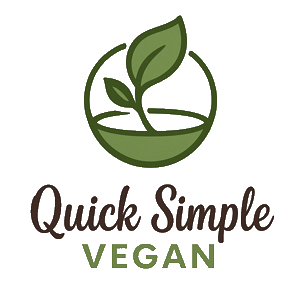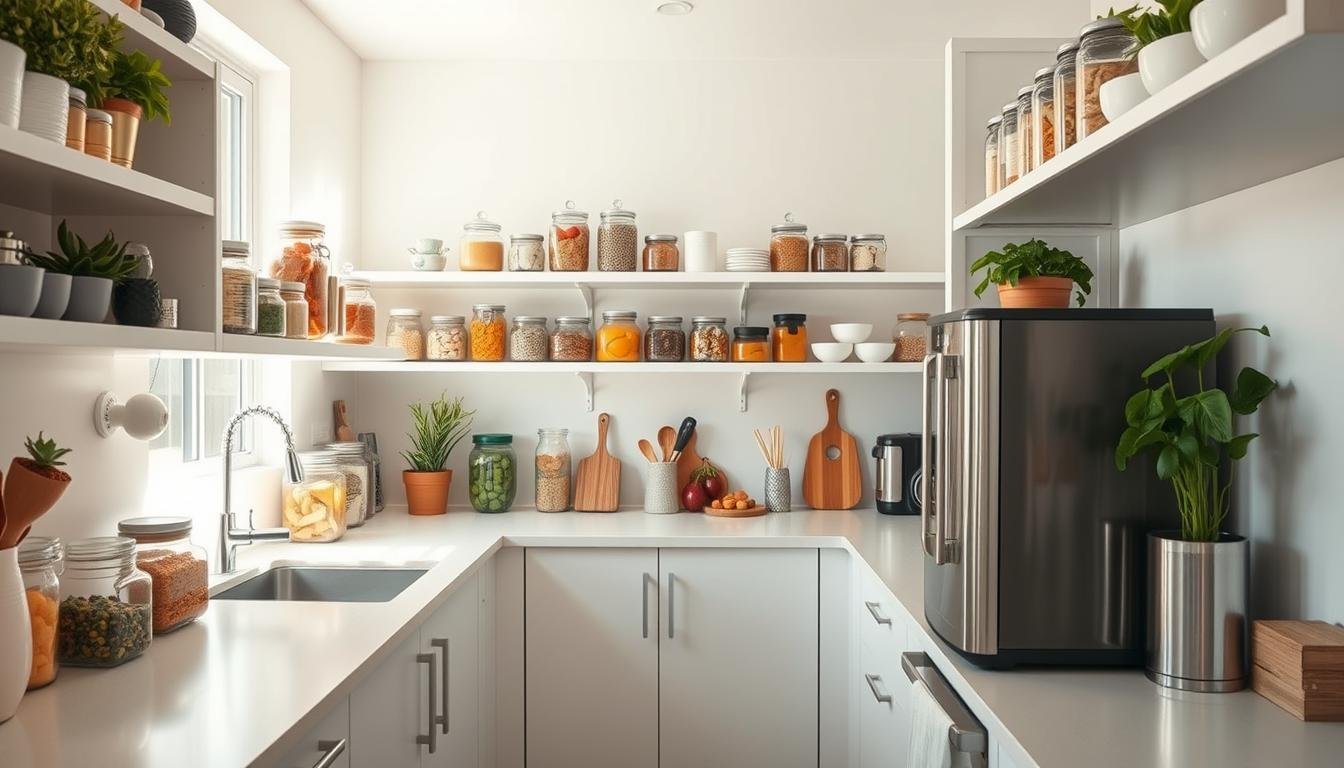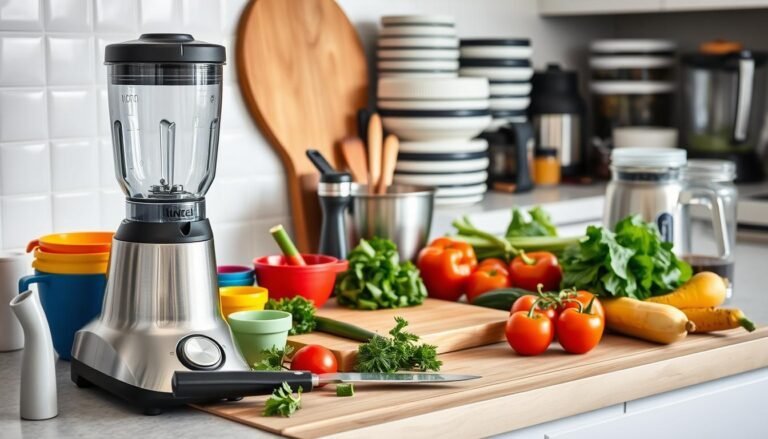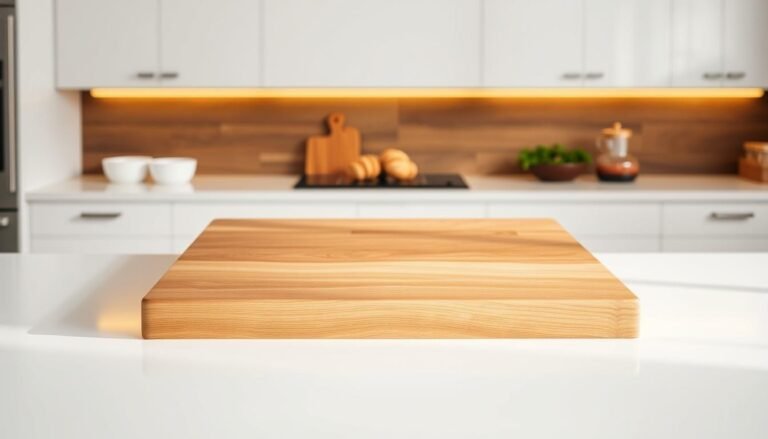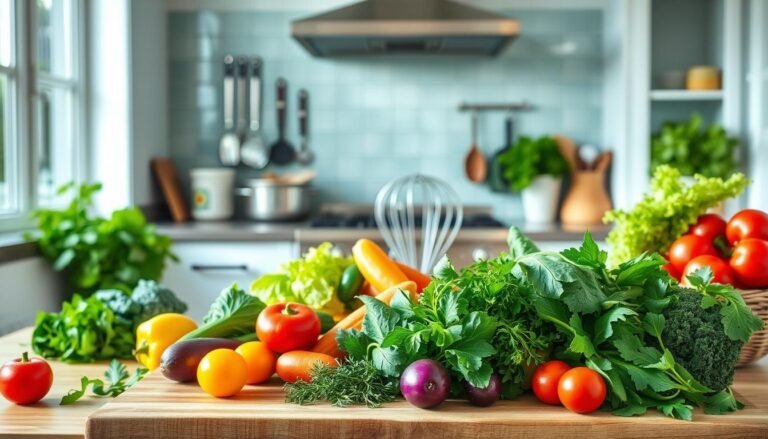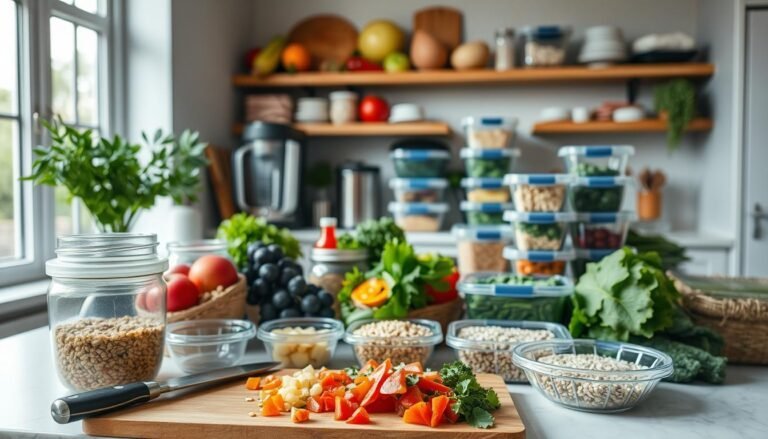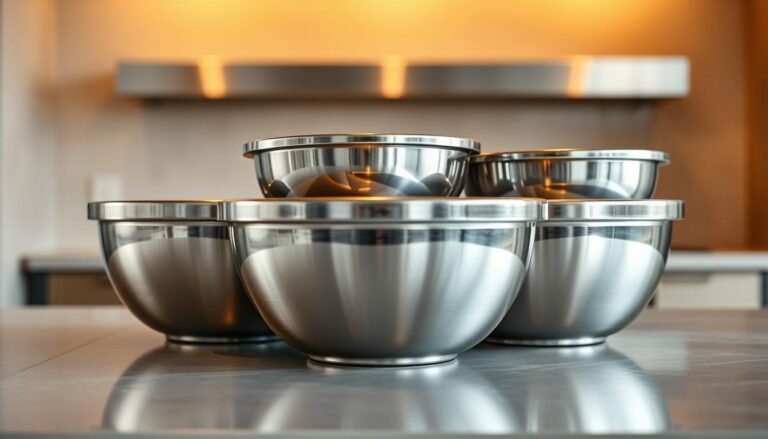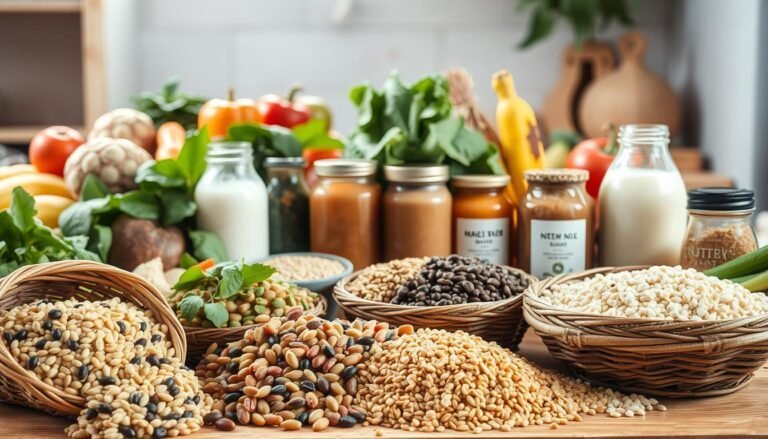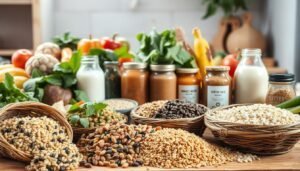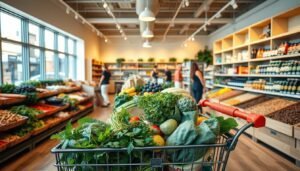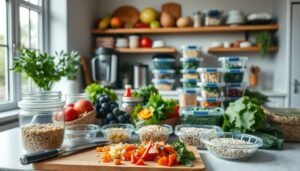Disclosure: This Post Contains Affiliate Links; We earn a commission on purchases.
A well-organized vegan kitchen is key to efficient plant-based cooking. It makes cooking easier and boosts creativity. It also helps avoid wasting food.
Stocking, cleaning, and optimizing your kitchen are important. They help make cooking smooth and fun. With good strategies, your kitchen can become a place for new recipes and ideas.
Key Takeaways
- Effective kitchen organization enhances cooking efficiency.
- Regular cleaning maintains a hygienic and clutter-free space.
- Optimizing kitchen layout improves workflow and productivity.
- Practical storage solutions reduce food waste and save time.
- A well-maintained kitchen inspires creativity and culinary exploration.
The Foundations of a Well-Organized Vegan Kitchen
Organizing a vegan kitchen makes cooking plant-based easy. A tidy kitchen makes cooking fun and efficient. It helps you prepare meals without stress.
Assessing Your Current Kitchen Space
Start by checking your kitchen’s layout. Look for areas that need better organization. One Green Planet says this is the first step to a great vegan kitchen.
Creating Functional Zones for Plant-Based Cooking
Split your kitchen into zones for different tasks. This makes cooking smoother and faster. For example, have a spot for chopping veggies and another for cooking.
Decluttering Non-Vegan Items
Get rid of non-vegan stuff to focus on vegan cooking. This keeps your kitchen vegan and avoids animal product mix-ups. A clean kitchen lets you cook with ease and confidence.
Essential Vegan Pantry Staples
A well-stocked vegan pantry is key to a great vegan kitchen. It helps you make many meals and keeps you ready to cook. Maintaining a vegan pantry means having the right stuff and keeping it tidy.
Dry Goods and Grains Storage
Dry goods and grains are must-haves in a vegan kitchen. Keep rice, quinoa, and pasta in airtight containers to stay fresh. Labeling these containers helps you find what you need fast, making cooking easier.
Legumes, Nuts, and Plant-Based Proteins
Legumes, nuts, and plant-based proteins are vital for vegans. They give important nutrients and can be used in many ways. Keep them in a cool, dry spot to keep them fresh.
Herbs, Spices, and Flavor Enhancers
Herbs, spices, and flavor enhancers make vegan food taste great. Organize your spice rack so you can find what you need easily. Think about using a spice carousel or magnetic strips on the wall for more space.
Inventory Management Systems
Keeping track of your pantry is important for maintaining a vegan pantry. Note what you have, what’s about to expire, and what you need to buy. Use a notebook, app, or spreadsheet to track your pantry and plan meals.
By following these tips, you’ll have a neat and useful vegan pantry. This makes cooking fun and easy.
Smart Storage Solutions for Plant-Based Ingredients
A well-organized vegan kitchen needs smart storage. Good storage keeps ingredients fresh and makes cooking easier.
Proper Container Selection for Bulk Items
For bulk items like grains and nuts, choose airtight containers. Glass containers or BPA-free plastic bins are great. They keep your food fresh and tidy.
- Use clear containers to easily identify contents.
- Label containers with the date and contents.
- Store containers in a cool, dry place.
Refrigerator Organization for Fresh Produce
Fresh produce needs careful storage. Use breathable bags or produce storage containers to keep it fresh. Organize your fridge by type.
- Keep frequently used items at eye level.
- Store raw meat and ready-to-eat foods in separate compartments.
- Regularly clean out expired or spoiled items.
Freezer Storage Strategies
Freezing is great for keeping ingredients fresh longer. Use airtight freezer bags or freezer-safe containers to avoid freezer burn.
Extending Shelf Life of Vegan Ingredients
To keep frozen ingredients fresh, label and date them. Store them in a way that’s easy to see what you have.
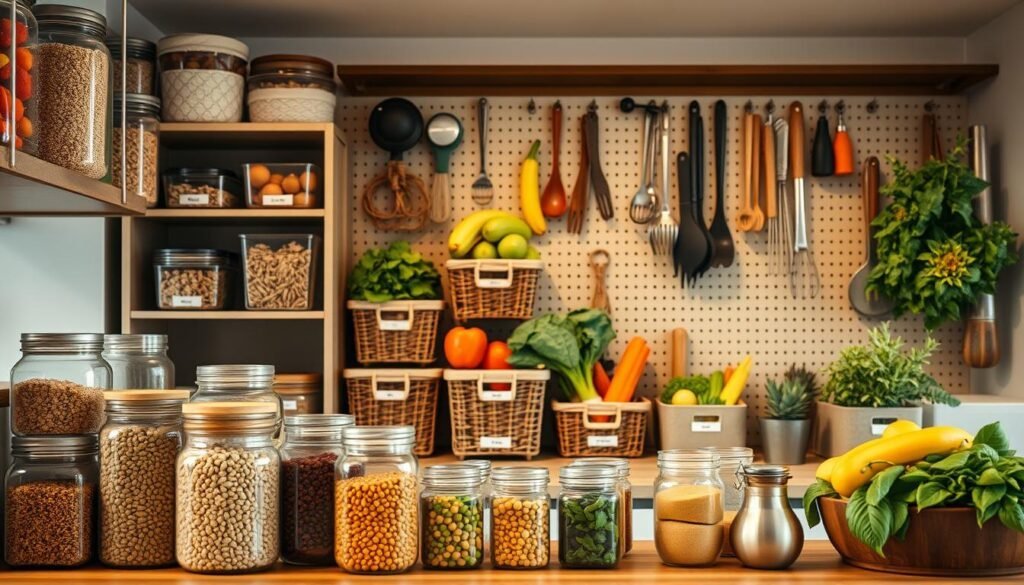
With these smart storage tips, your vegan kitchen will be organized. Cooking and meal prep will be fun.
Must-Have Tools for Your Vegan Kitchen
To make plant-based cooking easier, you need the right tools. A well-organized vegan kitchen is about more than just ingredients. It’s also about the tools and appliances that help you cook efficiently and enjoyably.
Essential Appliances for Plant-Based Cooking
Getting the right appliances can really improve your vegan cooking. You’ll need a high-speed blender for smoothies and soups. A food processor is great for chopping and slicing. And a slow cooker makes meal prep easy. My Darling Vegan says these appliances are essential for serious plant-based cooking.
Specialized Utensils and Gadgets
Special tools can greatly enhance your vegan kitchen. Think about getting a spiralizer for fun noodle dishes. A silicone steamer basket is perfect for healthy cooking. And a nut milk maker lets you make your own plant-based milks. These gadgets make cooking easier and open up more recipe options.
Eco-Friendly Kitchen Tools
Choosing eco-friendly tools is good for the planet and your health. Look for tools made from stainless steel, bamboo, or recycled materials. These are durable, safe, and better for the environment.
Space-Saving Storage for Kitchen Equipment
Keeping your kitchen organized is important. Use
- stackable containers
- drawer organizers
- wall-mounted shelves
to store your tools and appliances. This saves space and makes your kitchen more efficient.
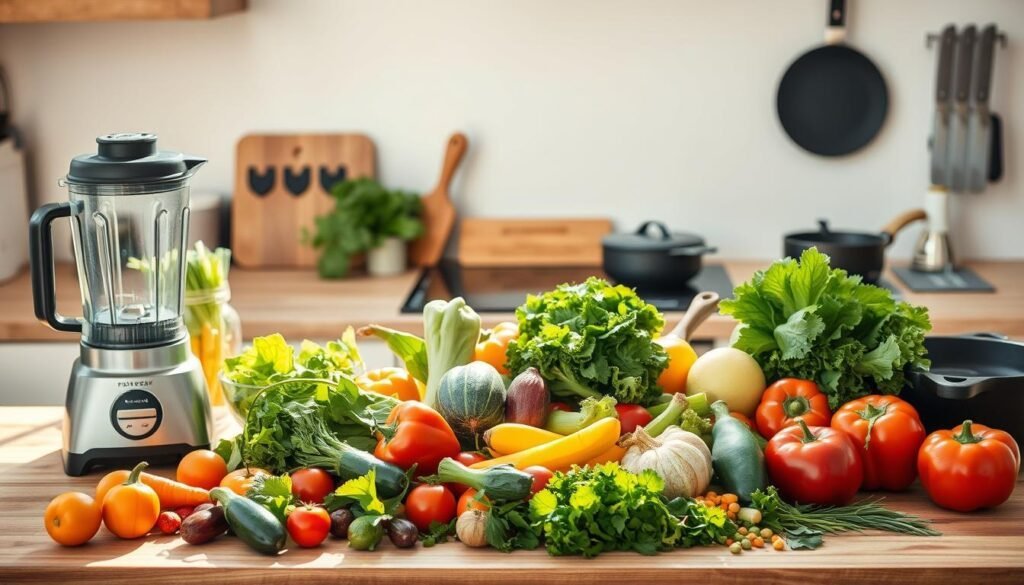
How to Organize and Maintain a Vegan Kitchen Efficiently
Keeping a vegan kitchen tidy is all about daily, weekly, and seasonal tasks. A routine helps keep your kitchen organized and working well.
Daily Cleaning Routines
Every day, clean up after meals by wiping down counters and sinks. Sweep or vacuum floors to stop crumbs and dust. For more cleaning tips, check out Eating Well.
Weekly Maintenance Tasks
Weekly, do deeper cleaning like the fridge, oven, and pantry. Check food expiration dates and throw away old items. This keeps your kitchen clean and efficient.
Seasonal Deep-Cleaning Strategies
Seasonally, do a deep clean of your kitchen. Clean the freezer, dust lights, and sort out cabinets. Natural cleaners work well for a thorough clean.
Natural Cleaning Solutions for Vegan Kitchens
Natural cleaners are good for the planet and your kitchen. Use vinegar, baking soda, and lemon juice for different surfaces. Baking soda and water can remove tough stains.
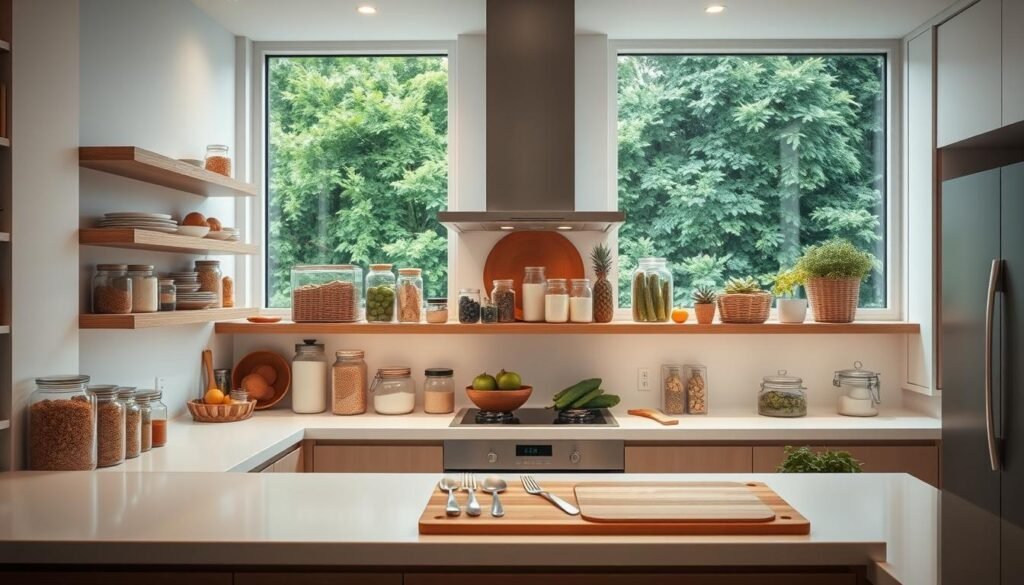
By doing daily, weekly, and seasonal tasks, your vegan kitchen stays efficient and fun to cook in.
Meal Prep Strategies for a Functional Vegan Kitchen
Setting up a cruelty-free kitchen needs a smart plan for meal prep. Good meal prep keeps your vegan kitchen running smoothly. It makes cooking less stressful.
Batch Cooking Fundamentals
Batch cooking is key in a vegan kitchen. It means making lots of one thing at a time. Then, you can use it later in smaller portions.
This saves time and makes sure you always have healthy food ready.
Food Prep Containers and Labeling Systems
Choosing the right containers and labels is vital. Air-tight containers keep food fresh. Clear labels help you know what’s inside and when it was made.
Time-Saving Organization Hacks
There are hacks to make meal prep faster. Like chopping veggies or cooking grains ahead of time. This cuts down cooking time later.
Efficient Workflow Planning
Planning your kitchen work is important. Create a meal prep schedule and a grocery list. Organize your kitchen to avoid extra steps.
This makes your kitchen work better and keeps you calm while cooking.
Using these strategies helps keep your vegan kitchen organized. It supports a healthy and kind lifestyle.
Troubleshooting Common Challenges in Vegan Kitchens
Vegan kitchens face special challenges. These include managing spoiled produce and dealing with mixed diets. Being ready helps keep your kitchen organized and efficient.
Managing Produce Spoilage
One big challenge is spoiled produce. Use a “first-in, first-out” rule for fruits and veggies. Clean your fridge often to keep things fresh. Plan meals to use up perishables before they go bad.
Dealing with Limited Storage Space
Storage space can be tight, even with bulk buys. Optimize your storage with stackable containers and baskets. Labeling containers helps you find what you need fast.
Accommodating Mixed-Diet Households
When not everyone eats vegan, you need to keep things separate. This means different storage for vegan and non-vegan foods.
Preventing Cross-Contamination
To avoid cross-contamination, use separate tools and boards for vegan and non-vegan foods. Label and store them clearly. Clean your kitchen and appliances often.
Conclusion
Organizing your vegan kitchen is key for easy plant-based cooking. By using the tips shared, you can make your kitchen neat and useful. This will make cooking more enjoyable.
Start by checking your kitchen layout and setting up zones for different tasks. Get rid of non-vegan items to keep things simple. Stock up on vegan staples and use smart storage to keep things tidy.
Keep your kitchen clean by setting up daily and weekly cleaning routines. Use seasonal deep-cleaning to keep things fresh. Meal prep helps too, like batch cooking and using containers.
Follow these tips to have a clean, efficient kitchen. This will help you enjoy cooking more in your vegan kitchen.
FAQ
What are the first steps to organizing a vegan kitchen?
How do I maintain a vegan pantry?
What are some smart storage solutions for plant-based ingredients?
What are the must-have tools for a vegan kitchen?
How can I keep my vegan kitchen clean and organized?
What meal prep strategies can I use in my vegan kitchen?
How can I manage common challenges in a vegan kitchen?
How can I optimize my kitchen workflow?

Focused on simplicity and flavor, Ryan helps readers create quick vegan meals and snacks without the overwhelm. Whether you’re new to vegan cooking or just want to keep it simple, Ryan’s tips, guides, and no-fuss approach make plant-based eating accessible and enjoyable for everyone.
Subscribe to Our Newsletter
